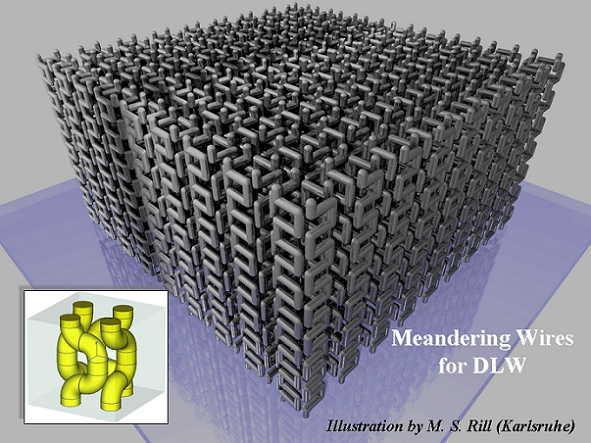
We were awarded NSF grant for optical metamaterials! [Apr 10, 2012]
We were awarded by National Science Foundation more than $180K research grant for three years to advance the photonic metamaterials. The project team includes Prof. Guney (PI), co-PI Prof. Costas Soukoulis (Ames Lab, IA), and collaborator Prof. Martin Wegener (Karlsruhe Institute of Technology, Germany). Metamaterials are man-made, usually periodic structures. Under incident electromagnetic waves with wavelengths much larger than the constituent unit cells, these heterogeneous structures behave as homogeneous materials with effective electric permittivity and effective magnetic permeability. Given desired permittivity and permeability, inverse problem of finding the corresponding unit cell underlies a wide variety of exotic things not possible with conventional optics such as perfect lens, ultra-sensitive sensors, high-precision lithography, optical analog computers, antimagnets, quantum levitation, invisibility cloaks, and more [1-8]. However, practical realization of all these applications demands (1) bulk (large volume) and low-cost fabrication methods. Additionally, the most fascinating applications driving the field such as diffraction-unlimited imaging and lithography simultaneously require (2) negative index of refraction, (3) low-loss, and (4) full isotropy. To date, theoretical structures proposed to satisfy these requirements simultaneously at (5) optical ranges, have turned out to be too complex for two-dimensional lithography.

Illustration of the blueprint for STED-DLW.
The project envisions prototype bulk metamaterial operating at mid-infrared frequencies using a combined “meandering wire” concept [9] and a novel three-dimensional (3D) stimulated emission depletion microscopy-inspired direct laser writing (STED-DLW) fabrication [10-13] technique followed by electroplating of gold [14] (see Figure above).
References
[1] J. B. Pendry, Negative refraction makes a perfect lens, Phys. Rev. Lett. 85, 3966 (2005).
[2] T. Xu, Y. Zhao, J. Ma, C. Wang, J. Cui, C. Du, and X. Luo, Sub-diffraction-limited interference photolithography with metamaterials, Opt. Express 16, 13579 (2008).
[3] J. B. Pendry, D. Schurig, and D. R. Smith, Controlling electromagnetic fields, Science 312, 1780 (2006).
[4] U. Leonhardt, Optical conformal mapping, Science 312, 1777 (2006).
[5] D. Schurig, J. J. Mock, B. J. Justice, S. A. Cummer, J. B. Pendry, A. F. Starr, and D. R. Smith, Metamaterial electromagnetic cloak at microwave frequencies, Science 314, 977 (2006).
[6] U. Leonhardt and T. G. Philbin, Quantum levitation by left-handed metamaterials, New J. Phys. 9, 254 (2007).
[7] D. O. Guney and D. A. Meyer, Negative refraction gives rise to the Klein Paradox, Phys. Rev. A 79, 063834 (2009).
[8] D. A. Genov, S. Zhang, and X. Zhang, Mimicking celestial mechanics in metamaterials, Nature Phys. 5, 687 (2009).
[9] D. O. Guney, Th. Koschny, M. Kafesaki, C. M. Soukoulis, Connected bulk negative index photonic metamaterials, Opt. Lett. 34, 506 (2009).
[10] S. W. Hell and J. Wichmann, Breaking the diffraction resolution limit by stimulated emission: stimulated-emission-depletion fluorescence microscopy, Opt. Lett. 19, 780 (1994).
[11] T. A. Klar, S. Jakobs, M. Dyba, A. Egner, S. W. Hell, Fluorescence microscopy with diffraction resolution barrier broken by stimulated emission, Proc. Natl. Acad. Sci. 97, 8206 (2000).
[12] S. W. Hell, Strategy for far-field optical imaging and writing without diffraction limit, Phys. Lett. A 326, 140 (2004).
[13] S. W. Hell, Microscopy and its focal switch, Nat. Methods 6, 24 (2009).
[14] J. K. Gansel, M. Thiel, M. S. Rill, M. Decker, K. Bade, V. Saile, G. von Freymann, S. Linden, and M. Wegener, Gold helix photonic metamaterial as broadband circular polarizer, Science 325, 1513 (2009).